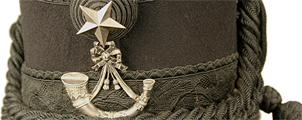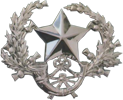New exhibition to mark 100th anniversary of the Armistice
A new exhibition has recently opened at Low Parks Museum to mark the 100th anniversary of the Armistice, signed on 11th November 1918.
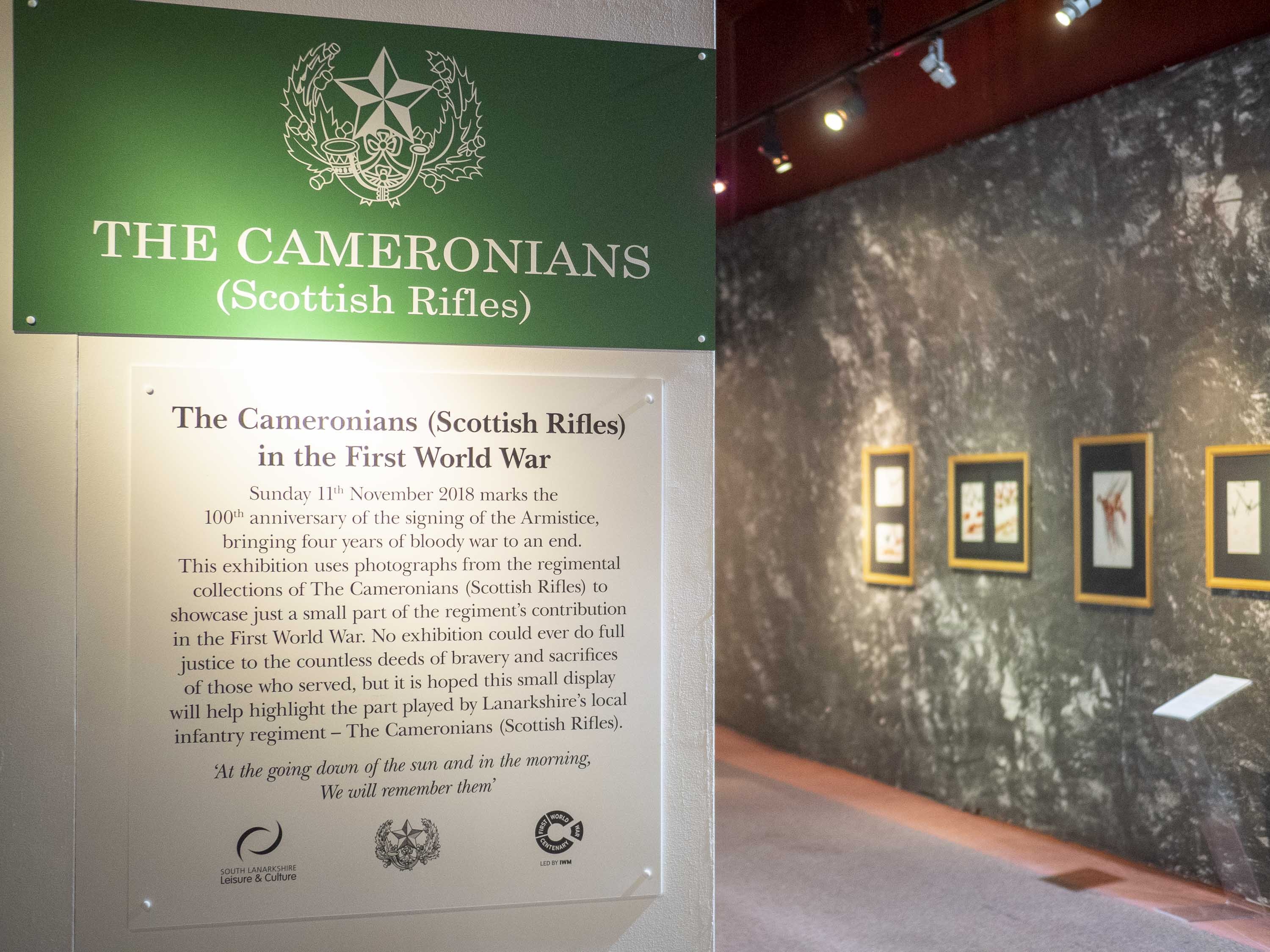
The exhibition uses unique photographs from the museum collection to highlight the contribution and sacrifices of The Cameronians (Scottish Rifles) in the First World War.
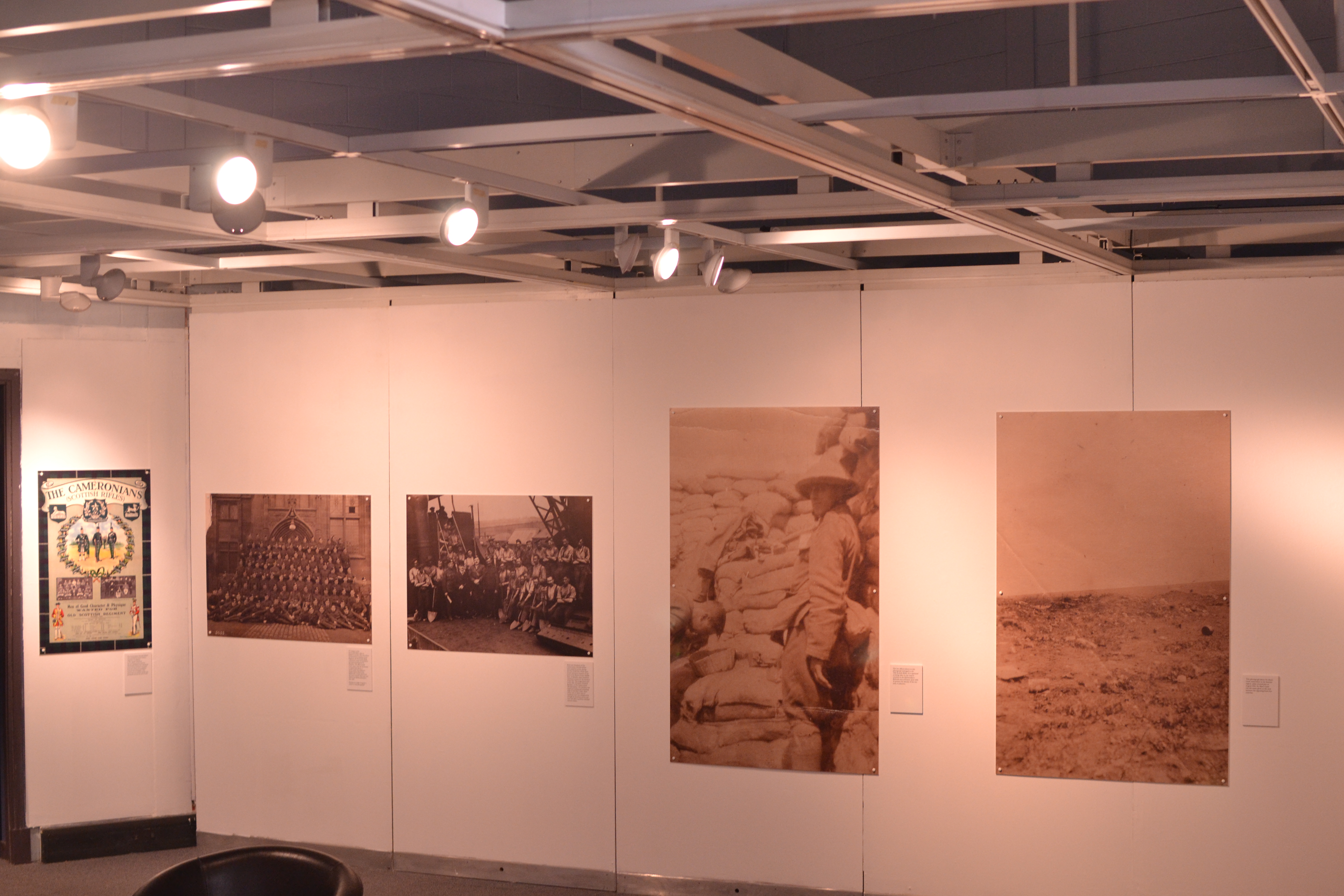

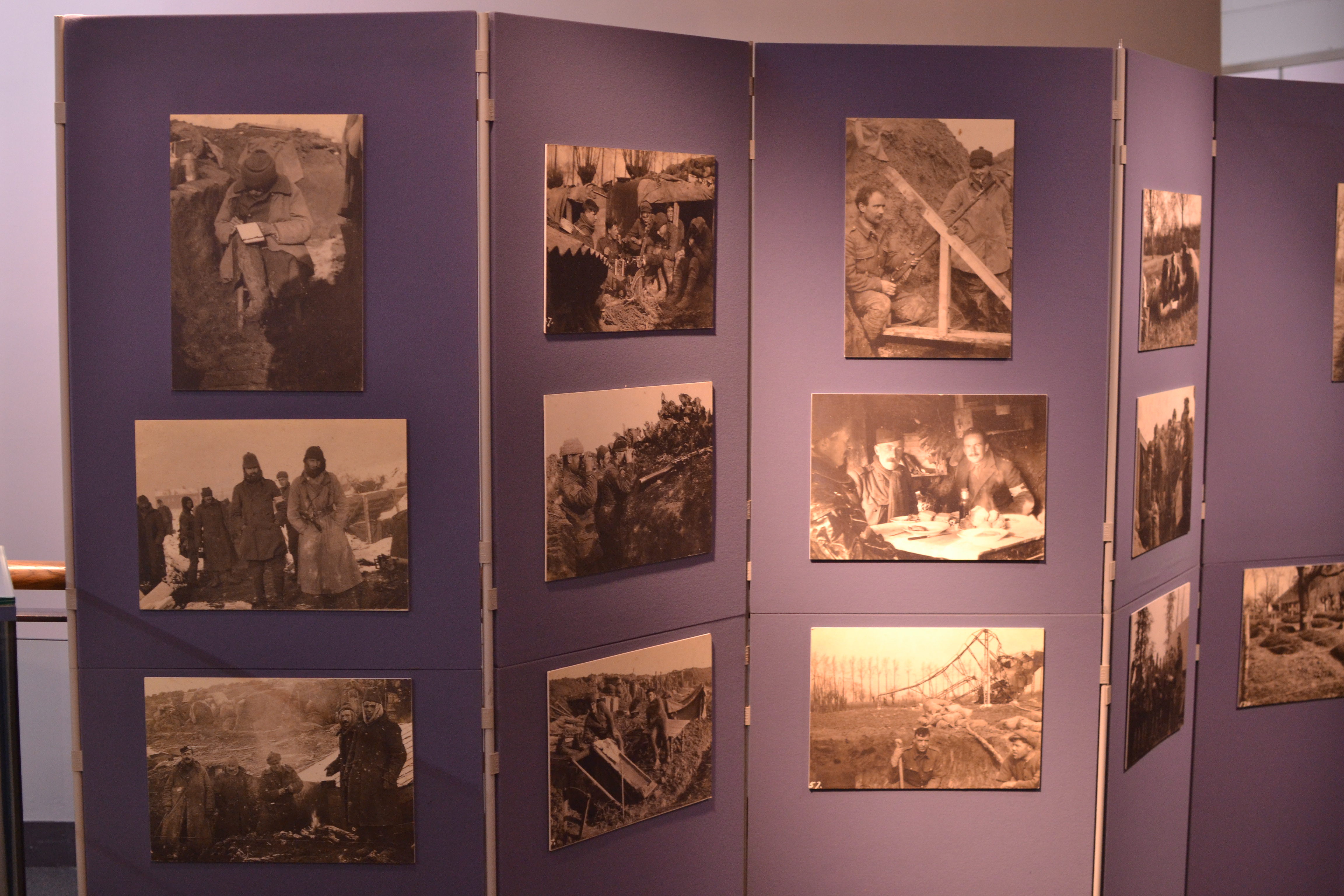
A short film presentation on The Cameronians (Scottish Rifles) in the First World War compliments the exhibition. This 10 minute feature was specially produced to commemorate The Cameronians involvement in the War, and utilises historical material from the museum collection along with modern images and film footage of sites, cemeteries and memorials on the Western Front.
A fantastic collection of artwork and sculpture by local artist, Allison Smith, completes the exhibition. Allison, whose grandfather served with The Cameronians (Scottish Rifles) during the First World War, collaborated with primary and secondary schools across South Lanarkshire to produce this moving and evocative display at Low Parks Museum.
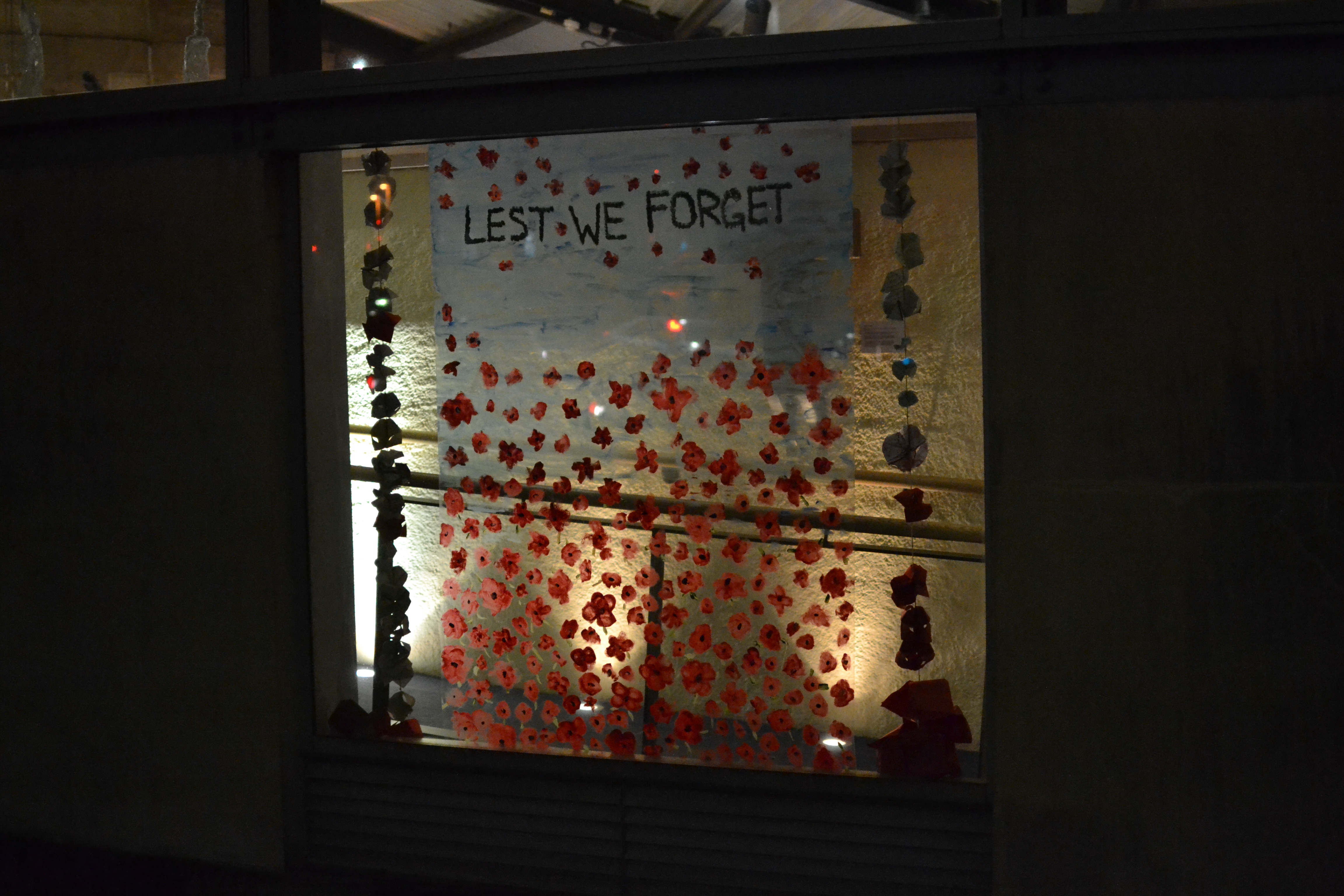
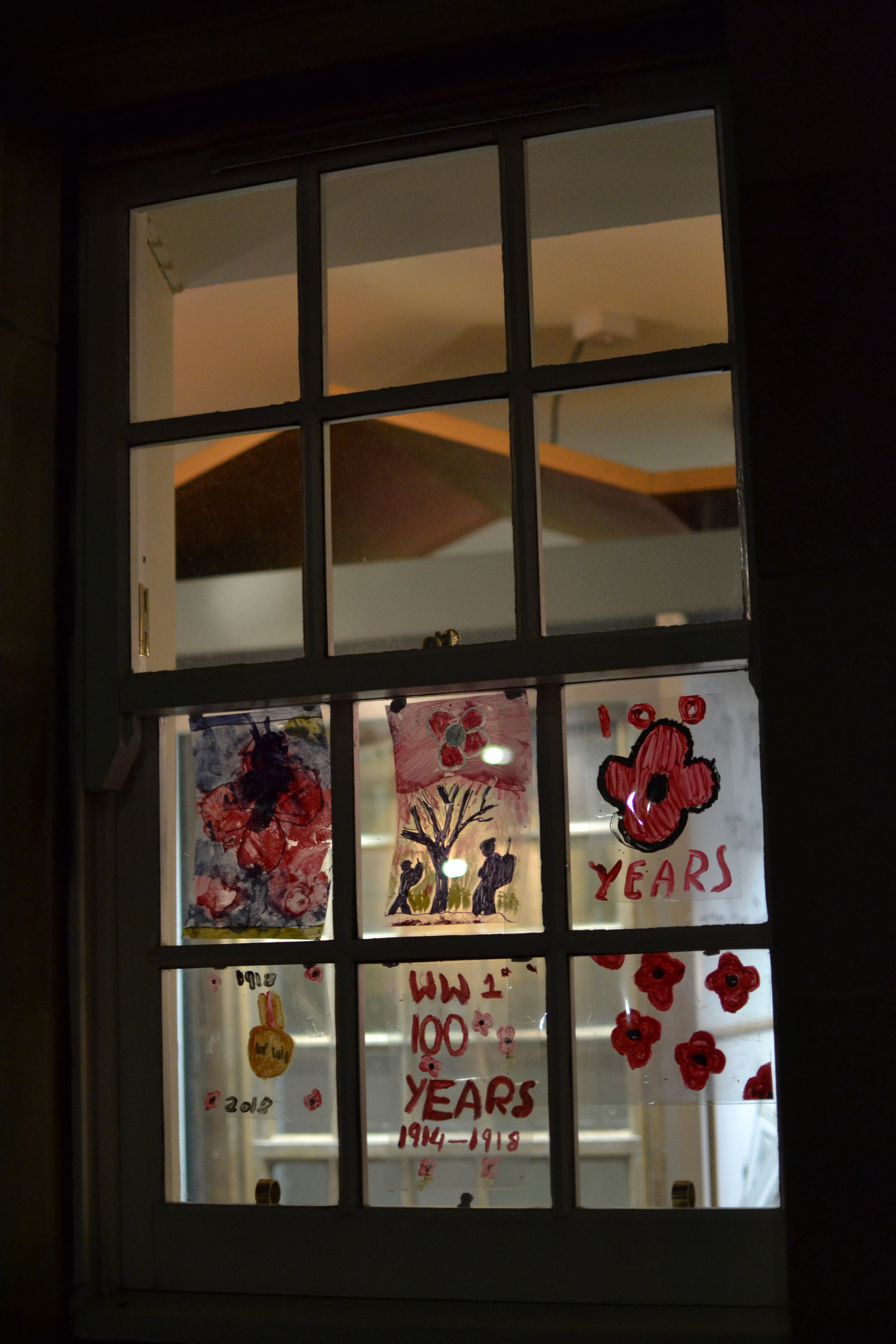
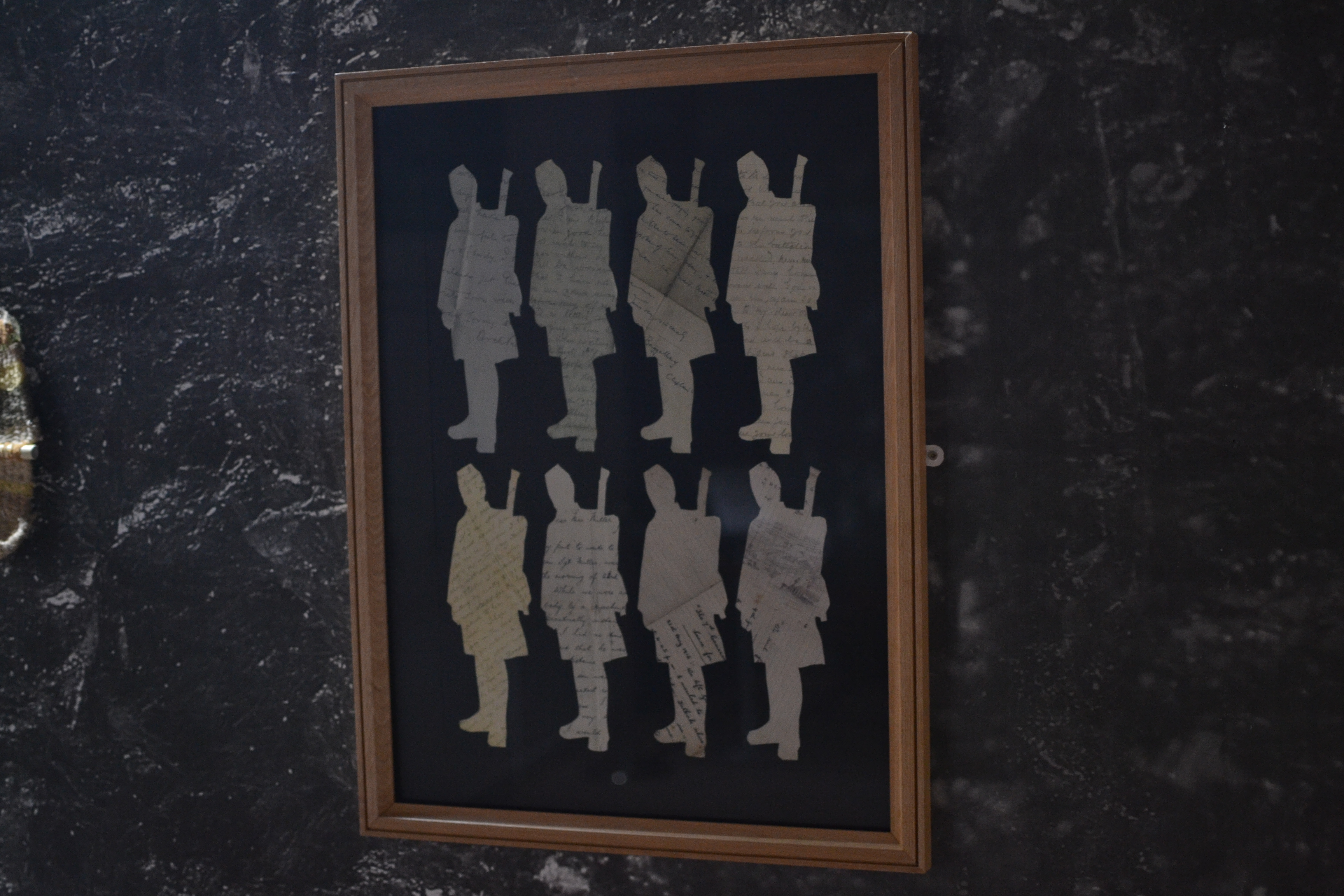
The exhibition and artwork installations are open now until Sunday 18th November, so please don’t miss out on the chance to come and visit. Entry to both the museum and exhibition is free of charge.
Comments:
Cameronians honoured in French town

The new plaque unveiled in memory of the 5/6th Scottish Rifles at Clary
Last week I had the privilege of representing the museum service at a moving ceremony in the French town of Clary. Tuesday 9th October 2018 was the hundredth anniversary of the action in which the 5/6th Scottish Rifles liberated Clary from German occupation, bringing to an end years of hardship and oppression. Shortly after the Armistice, the residents of Clary had paid tribute to the 5/6th Scottish Rifles and renamed the town square Place des Ecossais in honour of the Scottish troops who had won them their freedom.
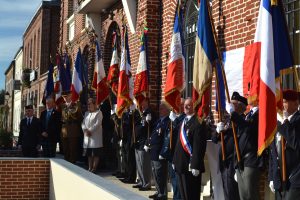
French veterans and standard bearers act as guard of honour to the unveiling party
One hundred years on, the residents of Clary once again commemorated the soldiers who had fought and died to liberate their town in a poignant ceremony held in the town square. A handsome marble plaque was unveiled on the wall of the Town Hall and commemorative crosses were laid by local children in memory of the soldiers who died in the actions leading to the town’s liberation.
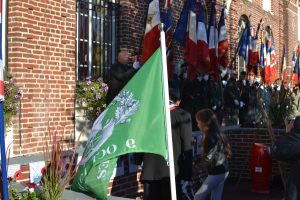
Local school children laying memorial crosses for those of The Cameronians (Scottish Rifles) who died on 9th October 1918
In a touching gesture of comradeship between Allies, the community of Clary presented me with a copy of the new plaque to display in Low Parks Museum. I’ll post more details about this over the next few weeks.
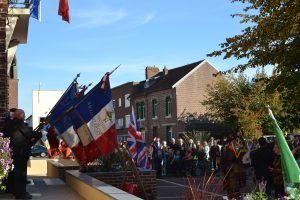
The standards dip as the crowd observe a moment’s silence in memory of those who gave their lives in the First World War
The genuine gratitude and sincerity expressed by the people of Clary in remembering The Cameronians was incredibly humbling and very moving to witness. What made the occasion even more special was the presence of the families of two members of the 5/6th Scottish Rifles who had fought at Clary in 1918. Several descendants of Colonel H. B. Spens D.S.O., who commanded the Battalion during the attack, were in attendance, including his grandson who was invited to assist in the unveiling of the commemorative plaque.

The newly unveiled plaque on the Town Hall of Clary. Under the plaque was placed a photograph of Colonel H. B. Spens, commanding officer of the 5/6th Scottish Rifles
Three relatives of Private Peter O’Hare, of Coatbridge, had traveled from Scotland to see their relative honoured. Peter O’Hare was one of the men who died in the action that led to the liberation of Clary. A number of other relatives of Private O’Hare held their own remembrance service at Coatbridge War Memorial in Scotland at the same time as the service was taking place in Clary.
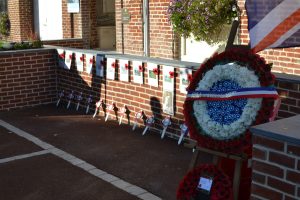
The wreath laid by the Mayor of Clary, the family of Private O’Hare, and Mr Adrian Smith on behalf of The Cameronians (SR) and Families Organisation. The wreath was made by the local school children
I have made several visits to the First World War battlefields of France and Belgium over the past twenty years, but seldom have I witnessed such a moving service and it is something I will never forget. Having seen firsthand how dedicated the people of Clary are in honouring the men of the 5/6th Scottish Rifles, it is safe to say that the memory of these men is in safe hands.
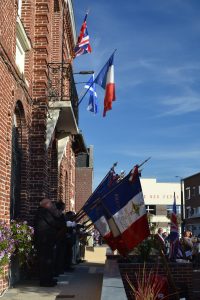
Comments:
The Battle of Hamilton 1936
The Battle of Hamilton, July 4th-5th 1936
On Saturday the 4th of July 1936, the 6th Territorial Battalion of the Cameronians (Scottish Rifles), with close air support from 602 “City of Glasgow” Bomber Squadron of the Auxiliary Air Force, fought their way across the River Clyde from Motherwell to Hamilton. Their objective: to retake Hamilton from an enemy force. The enemy had blown up the Clyde Bridge on the main road down from Motherwell, so the 6th Battalion had to construct a pontoon bridge and assault the banks of the Clyde on the Hamilton side before fighting their way into the town itself, all the while under hostile fire. Above them, the aircrews of 602 Squadron would attempt to suppress the enemy fire before attacking targets in Hamilton itself. A huge and complex undertaking for the part-time soldiers and airmen to attempt.
It sounds like the plot of an epic war film and in a way it was, for this was the huge mock battle that was staged as an exercise that summer. According to the press reports, it was one of the largest military exercises ever to be held in public in Scotland up to that point in time. An estimated 35,000 people would watch the exercise take place with crowds crammed onto the “blown up” Clyde Bridge watching the action unfold above and below them.
It was Lt. Colonel Galloway, the Hamilton Depot’s Commanding Officer, who had drawn up the exercise. The scenario was that war had broken out four days earlier. The “Westland” army, in retreat, had destroyed the bridge and seized a major ammunitions factory in the then village of East Kilbride. The men of the 6th Territorial Battalion under Lt. Colonel Kerr and 602 Squadron, then still under the command of The Marquis of Clydesdale, were the elements of the “Eastland” forces tasked with retaking Hamilton and establishing the Clyde bridgehead for the push onto East Kilbride itself. With the full cooperation of both Motherwell and Hamilton Town Councils, the free use of both the Motherwell Park and the Hamilton Low Parks were granted and an enclosure was built on one side for the family and friends of the soldiers taking part to watch from. It had been well advertised in the newspapers beforehand and many were keen to see their local soldiers at work, so huge crowds had gathered on the surrounding hillsides and on the bridge itself.
Among the crowd, albeit mostly ignored, was a small but vocal anti-war demonstration by members of the Communist Party, complete with a loudspeaker equipped van proclaiming “Mock war today, real war tomorrow!”
Arriving from their billets in Newmains, the 15 officers and 270 other ranks* prepared their kit at lunchtime, ready for the assault. After mustering at the Motherwell Drill Hall at 3.30pm, the men then moved out and assembled at their first objective, the Motherwell Park river bank, by 4.20pm. Today, the banks where the River Avon meets the Clyde are covered by dense trees and the M74 Motorway runs close to the Hamilton side. But in 1936 they were clear and open, a perfect location for a bridging assault.
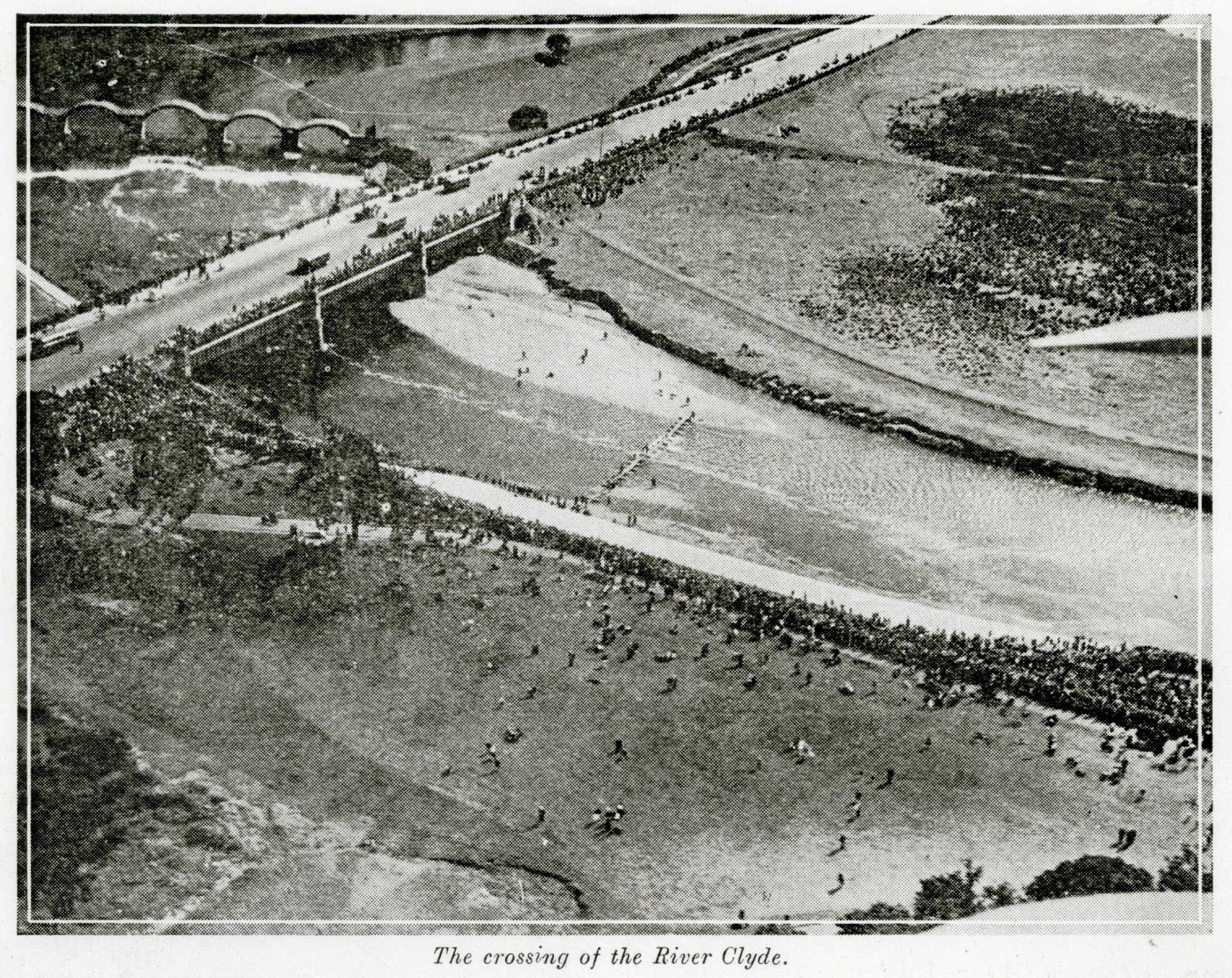
Aerial photograph of the bridging operation as published in the Covenanter a few months later
The 101st Field Brigade, Royal Artillery gave them covering fire in the shape of smoke bombs to simulate the shellfire and the sleek, silver Hawker Hart biplanes of 602 Squadron swooped down and proceeded to lay a covering smokescreen. A kapok pontoon footbridge was then thrown across the Clyde by the men of D Company, a difficult task as the previous days rain had swollen the river considerably and strengthened the current. The bridge was constructed along the Motherwell bank and with men already in the water was swung out into the flow of the Clyde. Once it had been secured on the Hamilton bank, the men of A and C Companies ran across to secure the bridgehead. Their only casualty was a Sergeant who fell headlong into the river, much to the vocal and unsympathetic amusement of the spectators! The men of D Company were later singled out for fulsome praise for their skill and quick reactions in building and securing the bridge into place, despite the river conditions, by their commanding officers. The press reporters recorded that the crowds on the Clyde Bridge were quite taken by seeing the soldiers dressed merely in bathing costume, due to the length of time they had to spend in the water.
With A and C Companies safely across the Clyde the bomber crews of 602 Squadron now turned their attention onto the enemy positions in the town and the Low Parks as the Cameronians fought their way in. A series of low-level attack runs commenced to support the advancing troops, which would have been a spectacular sight and sound for the citizens of Hamilton. This must also have been a surreal moment for 602’s commanding officer, attacking the remnants of the Hamilton Palace which his father had inherited in 1895 on becoming 13th Duke of Hamilton and where he himself had spent part of his childhood. Thousands of rounds of blank ammunition were exchanged between the pilots and gunners and the anti-aircraft machine gunners on the ground, to their evident enjoyment! The Marquis of Clydesdale was of course well known for flying the first aeroplane over Mt. Everest in 1933, so the squadron and the regiment were both very much linked through their connections with the Douglas-Hamilton family. On board one of the Harts to observe the exercise from above was Major General Fortune, the then commanding officer of the 52nd Lowland Division.
An unplanned addition to the exercise then took place which was definitely not on Lt. Colonel Galloway’s schedule. The commotion caused by the low flying aeroplanes and gunfire had an unexpected effect on some in the Low Parks; a herd of the legendary white cattle grazing beside the Hamilton Mausoleum got so annoyed with the noise that a stampede then broke out in the direction of the troops. However, on encountering the men of the 6th Battalion, the cattle tactically withdrew back to the relative calm of the former Ducal resting place.
By 6.30pm all objectives had been achieved according to the exercise umpires, the 6th Battalion had secured Hamilton and had pushed out the enemy forces. For this the troops were rewarded with an issue of tea and pies! The men then fell in and with the Battalion Band at the front of the column they proudly marched off through Hamilton to camp for the night in the Cadzow Rifle Ranges. There, the men settled down for some fine evening entertainment in the shape of some competitive inter-company boxing bouts.
The following day, there was an inspection of trench fortifications prepared earlier in the week by the troops and demonstrations of section and platoon tactics and manoeuvres. This brought the exercise to an end and the Battalion was dismissed that afternoon to great praise and compliments from all of the senior officers present for a very successful two days of operations.
Peter Kerr, Low Parks Museum, 2018
*As quoted in “The Covenanter”, contemporary press reports said 400 men took part but this number might have included the Artillerymen and other regimental officers and personnel present.
Comments:
Posted: 05/07/2018 by PeterKerr in Events
“We have to go now, Sir! It is time for us to go.”
These were the immortal words spoken by Lieutenant Colonel L. P. G. Dow to the Commander-in-Chief in Scotland on 14 May 1968, signalling the time had come for the 1st Battalion The Cameronians (Scottish Rifles) to disband.
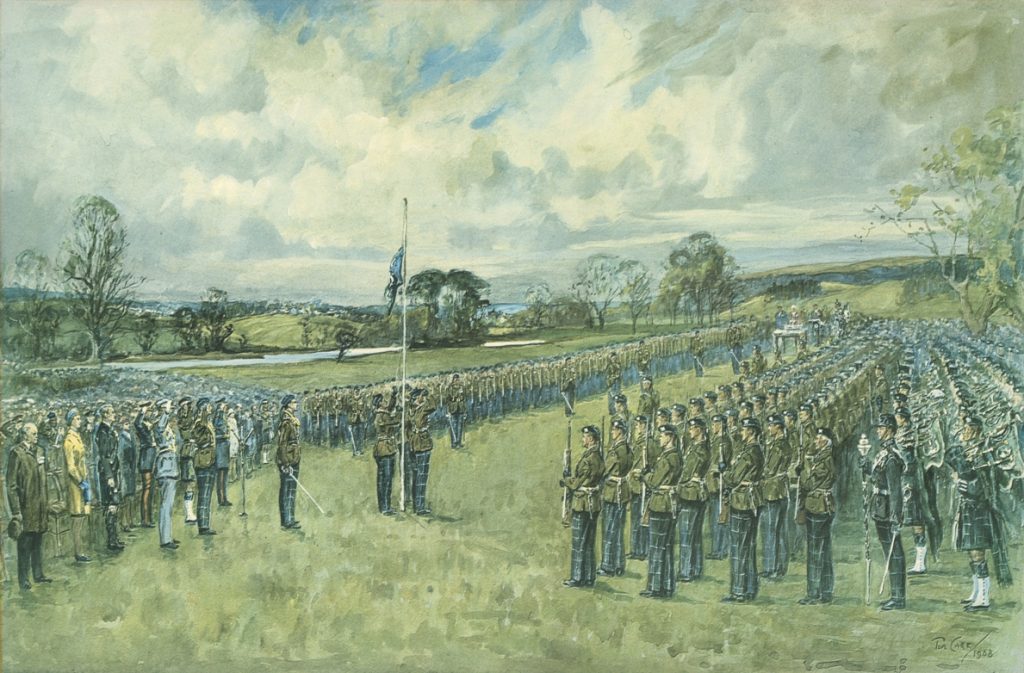
Watercolour of the 1st Battalion’s Disbandment Service, by Tom Carr, 1968
14 May 2018 marks the 50th anniversary of the Disbandment of the 1st Battalion The Cameronians (Scottish Rifles), as a result of reductions to the UK Defence budget. Despite being raised in 1689 (as the Earl of Angus’ Regiment), The Cameronians were the junior regiment of the Lowland Brigade and it was to them that the bitter choice to amalgamate or disband was given. As it would not have been possible to preserve its unique history and traditions on amalgamation with any other regiment the painful decision to disband was taken.
So it was that on May 14 1968, at Douglas, the 1st Battalion The Cameronians ‘marched from the Army List and into history’. The majority of officers and men remained in the Army, transferring to other regiments and Corps. The name of the Regiment lived on through companies of the Lowland Volunteers and the Army Cadet Force until 1996 when they were rebadged and affiliated to other regiments. Further reduction of the army in 2006 brought the end of the names of all the Scottish infantry regiments, which were merged into the newly created Royal Regiment of Scotland.
While The Cameronians are no longer a part of the British Army, they are remembered with pride across the world; in foreign lands where they fought to liberate the oppressed and help preserve peace, and in Lanarkshire, their home. Low Parks Museum is the proud custodian of The Cameronians regimental collections, through which the Regiment’s name lives on in perpetuity.
To commemorate this momentous occasion in the Regiment’s history, we have created a small display within Low Parks Museum showing some key objects from the regimental collection that relates to the disbandment of the 1st Battalion. One of the objects in this display is the insignia of a Commander of the Swedish Order of the Sword, which had been presented to Lieutenant Colonel Dow on the morning of the disbandment service. The honour was bestowed on behalf of His Majesty King Gustaf VI Adolf of Sweden, Colonel in Chief of The Cameronians (Scottish Rifles).

Neck badge of a Commander of the Swedish Order of the Sword, presented to Lt-Col L. P. G. Dow
It was possibly with mixed emotions that Dow received such an honour, given that his first opportunity to wear it was at the disbandment of his Battalion. As Commanding Officer, Dow had the painful task of formally disbanding the 1st Battalion – bringing almost 300 years of service to an end. The date chosen for the disbandment service was symbolic; the anniversary of the founding of the Earl of Angus’ Regiment 279 years earlier. Douglas was where that regiment had been raised and it was only fitting that that is where the disbandment of the 1st Battalion should take place.
The first Commanding Officer of the Earl of Angus’ Regiment was William Cleland, the young, veteran commander of Covenanting forces at Drumclog and Bothwell Bridge. Cleland had the honour of commanding his regiment in it’s first victory, at Dunkeld on 21 August 1689. The victory was tainted by tragedy as Cleland was among those killed in the action. His sword would go on to become one of the Regiment’s most treasured relics, and was placed on the Communion Table on the day of the disbandment, a physical reminder of the first Commanding Officer of the Regiment.

The sword of Colonel William Cleland
Cleland was a man of words, and indeed left behind a legacy of poetry in addition to his accomplishments as a soldier. After his death, a poem dedicated to him by an unknown author was included in a collection of Cleland’s works.
It is titled ‘An Acrostik Upon His Name’ and reads:
Well, all must stoop to death, none dare gainsay.
If it command, of force we must obey:
Life, Honour, Riches, Glory of our State
Lyes at the disposing Will of Fate:
If’t were not so, why then by sad loud thunder
And sulph’rous crashes, which rends the skies asunder
Must a brave Cleland by a sad destiny
Culled out a Victime for his country die.
Lo, here’s a divine hand, we find in all,
Eternal Wisdom has decreed his fall.
Let all lament it, while loud fame reports,
And sounds his praise in Country, Cities, Courts.
No old forgetful Age shall end his story,
Death cuts his days but could not stain his Glory.
Lieutenant Colonel Leslie Dow, last Commanding Officer of the 1st Battalion The Cameronians (Scottish Rifles), wrote his response in 1968, in dedication to William Cleland:
Another Acrostik Upon His Name
Would you approve of how the tree has grown?
I like to think so. You bequeathed your own
Love of a harassed land and honest cause,
Love which without advertisement or pause
Inspired a hundred Clelands less renowned
And warms platoons of Thompsons in the ground,
Men who have walked this road and shared this view.
Campbell and Lindsay forged the sword with you.
Lit by your pride they handed on the text,
Each generation shaping up the next.
Lindsay and Campbell finish it today.
Axed lies the tree. Now put the sword away,
No old forgetful age will end our story,
Death cuts our days but could not stain our Glory.
The first and last Commanding Officers, William Cleland and Leslie Dow, share one other, remarkable connection. Leslie Phillips Graham Dow was baptised on 16 February 1926 in the Cathedral Church of St. Columba, Dunkeld, the final resting place of Lieutenant Colonel William Cleland.
In 2007 a tree was planted at the National Memorial Arboretum, dedicated to The Cameronians (Scottish Rifles). It is fitting that the accompanying plaque bears the last two lines of Colonel Dow’s poem, quoted above.

The plaque accompanying the Regimental Tree, at the National Memorial Arboretum.
Comments:
Posted: 11/05/2018 by BarrieDuncan in Collections, Events
Merry Christmas and a Happy New Year
As we prepare to say farewell to 2016, we would like to take this opportunity to wish all our visitors a very Merry Christmas and a Happy New Year. We would like to also say thank you for visiting Low Parks Museum, our website, and reading our blog posts on The Cameronians (Scottish Rifles) museum collection.
We will leave you with this Christmas card from The Cameronians museum collection. It was sent from Pat to his ‘chum, Len’, most likely for Christmas 1927.
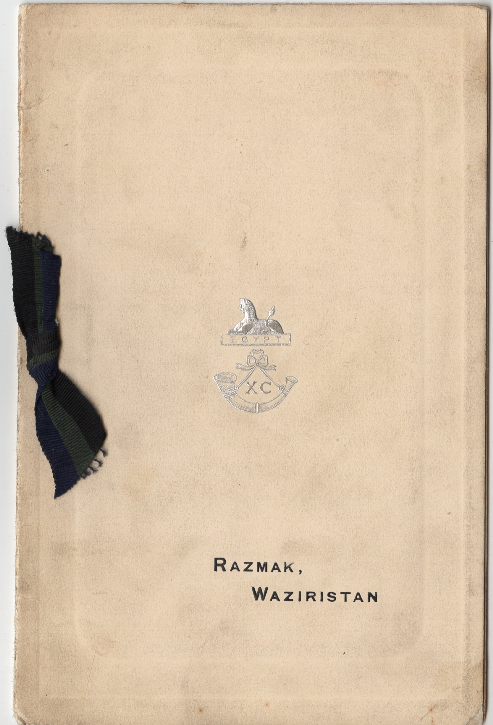

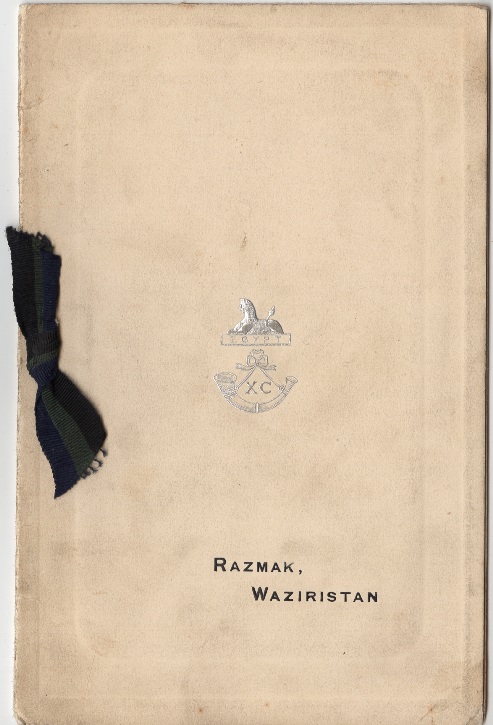
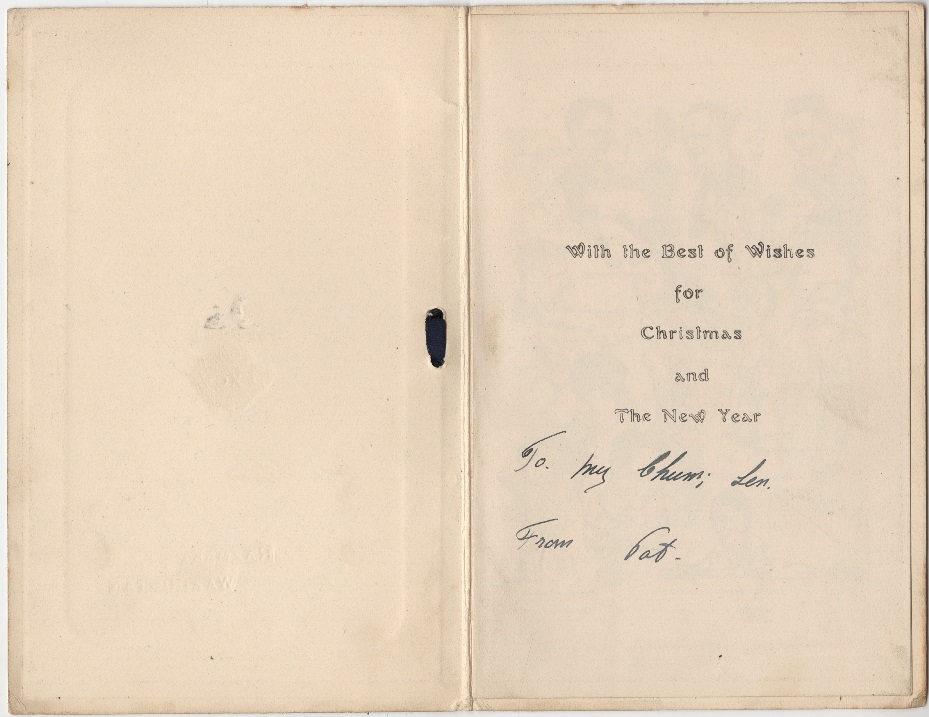
Unfortunately we don’t know anything about Pat or Len, but hope the caricatures contained in the card will be of some interest. They were sketched by J. E. B. Whitehead, an officer of The Cameronians who went on to have close involvement in the running of the Regimental museum.
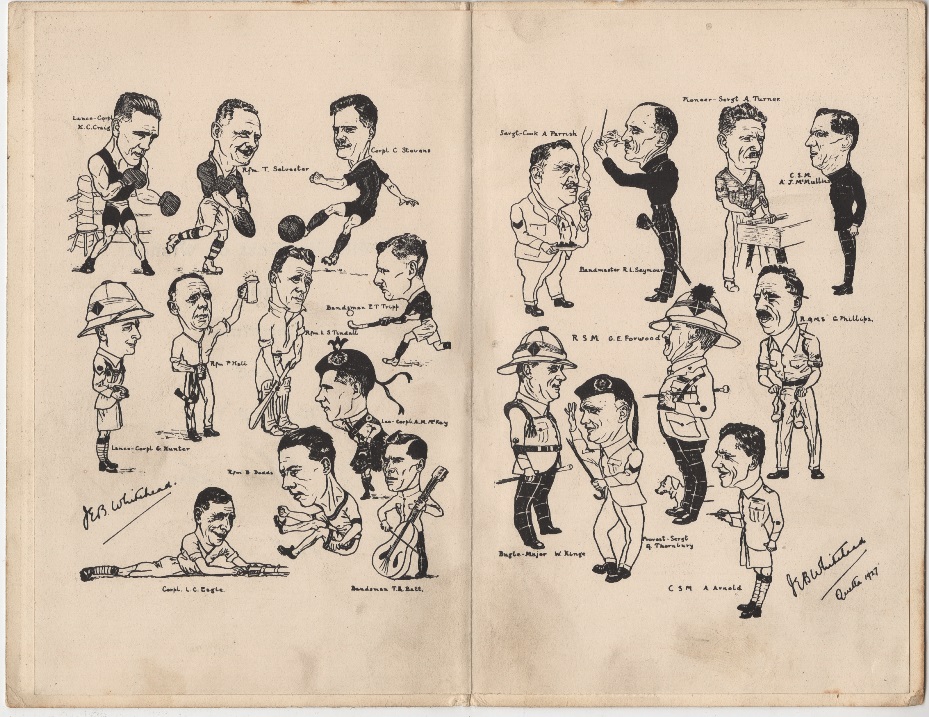
The sketches show a selection of ‘characters’ from the 2nd Battalion serving at that time (1927), including some of the Warrant Officers and Senior Non Commissioned Officers. Perhaps someone out there might recognise a relative!
We’ll see you all in 2017!
Comments:
Posted: 23/12/2016 by BarrieDuncan in Collections, Events
Log in







